Life Lessons from a Tummo Retreat

How to survive a week in the snow in your bikini!
When I signed up for a week Tummo retreat with Patrick Daubard in Italy, I imagined that I would be learning some breathing techniques and participating in some cold exposure practices. What I actually experienced was a deeply spiritual, emotional, mental and physical journey that gave me insights on how to deal with challenges in life. I also gained a deep connection with meaning, purpose and motivation in life. Amazing new skills and tools for living a Mindful Life.
What is Tummo (or Toumo)?
Tummo has it’s roots in Buddhism and is a practice which involves generating inner heat through breathing techniques, visualiations and meditations. But this definition only scratches the surface of the personal and spiritual growth awaiting practitioners.
What drew me to Tummo?
As a wellbeing coach I am always reading and researching new techniques for supporting the bodies natural healing processes and to support health. Last year, I read James Nestor’s book, “Breath”, and was very inspired and curious when I read about the practice of Tummo in Chapter 8. Health benefits associated with Tummo include helping to reset the nervous system and the immune system. As a mindfulness practitioner I was also interested in learning new meditation and breathing techniques.

Morning Tummo walk in the snow – Aosta, Italy 2024
The Five Foundations of Tummo – Les Cinqs Fonamentaux
At the start of the retreat Patrick shared with us the five foundations of the Tummo practice:
- JOKANG – this involved sacralisation of the space before the practice. So for example, when you are preparing for a sitting meditation, being present and carefully laying out your blanket, your cushion. When I go for a dip in the sea, I carefully lay out my plastic on the sand, my towels, clothes etc. Doing so carefully, with great respect and, importantly, in silence. Also an acknowledgement that you are about to do a spiritual practice.
- RELAXTION – as you prepare to expose yourself to the cold – for me especially I had a great fear of the cold water – it is important to allow the mind and body to relax. Coming back to the breath. Letting go of negative thoughts in the mind. Letting go of tension in the body.
- SIDDHASANA – this is the posture used for seated meditation. Something to keep awareness of – especially in the cold, when your natural response might be to curl up and contract the body. This posture helps you to open up to the cold. And also supports the breathing and meditation techniques that generate the inner heat
- RESPIRATION – this might be strange but it is important to continue to breathe when you are doing Tummo practices! For example, when you enter the cold water, your natural reaction is to hold your breath. This will only increase the bodies stress response to the very cold temperature. So, keeping an even and steady inhale and exhale really supports the body to adapt to the cold and reduces the stress.
- ÉTAT D’ESPRIT or state of mind. This is very much a combination of all of the above points. Moving into a spiritual state of mind, a relaxed state of mind, breathing, trusting the body, lashings of self-compassion and kindness as well as a determined motivation.

Dawn Tummo meditation – Aosta, Italy 2024
Lessons learned from a Tummo Retreat
It was a super challenging week physically, mentally and emotionally. And through these challenges I gained many powerful insights. I would like to share these with you here.
So what got me out of bed to meditate in -8 degrees or to submerge myself in the icy pool each day? 3 things:
- My Sankalpa – or intention that I set at the start of the retreat. This was my resolution for positive change that I wanted to see in my life as a result of these spiritual practices
- There is only one space in our heart – this space can be filled with “I”, which can leave us open to fear. Or we can place humanity in our heart – this gives us the confidence to show up, and remember that we are serving a wider purpose through our actions
- Offering my practice for all those people who are suffering in the world – this was super powerful and motivated me to continue. I was choosing to put myself in a challenging situation, what about all those people who do not have a choice in their suffering (be it famine, war etc)? This insight has been transformative for my meditation practice in general also
The power of the group
Lessons in compassionate leadership
- Just because you are feeling good during an experience does not mean others are not suffering or struggling. Be mindful of this. Be sensitive and compassionate
- Even more advanced practitioners have their doubts
- Allow others to face their difficulties without trying to “save them”. Challenges offer human beings the greatest opportunities for growth in life – who are we to step-in and take that opportunity away from someone?
- However, we can embody “I am here to help if you need me”. Qualities like openess, approachability, the expression on our face, lets others know that if they need help they need only ask
- It’s ok to call something “tough”. It is tough. Avoid fake positivity. Be vulnerable. It is not a sign of weakness, it is a sign of strength
- And finally a phrase that stayed with me – a phrase coined by Georges Hébert and later taken on by the French Military – “Be strong to be useful”. Tummo has many health benefits and there are many ways we can support our health. If I can take care of my body, stay energised and strong I can then be of more use to humanity.

Key Tips for facing the cold in Tummo practices
These were the most helpful tips I received during the retreat for facing the challenges I experienced (especially when facing the cold water):
- Trust the body – it knows what to do
- Surrender and open up to the cold
- Appreciate the view
- Appreciate the moment
- Reassure the body, “You are not going to die”. This helps to shift from the sympathetic nervous system (fight, flight or freeze) to the parasympathetic nervous system. The body remembers, the mind forgets
- Dedicate the practie to all those who are suffering in the world

Sharing my experience at the end of the Tummo retreat – Aosta, Italy 2024
How I incorporate Tummo into my Mindful Living routine
After such a profound spiritual experience on the retreat, I spoke with some of my fellow participants to find out how they continue the practice in their everyday lives. While I don’t live near snowy mountains, I am fortunate to live by the sea and in a country with cold weather and long winters. So here is how I continue my Tummo practice in The Hague:
- A morning dip in the sea – and inviting others to join me for motivation (including my husband and neighbours)
- Sitting in the garden at dawn and doing a short meditation in my shorts and vest
- Going for walks without my hat and scarf – I haven’t graduated to no jacket yet!
- Cold showers (you can build this up slowly)
- Incorporating the État D’Esprit of Tummo into my everyday life and using the life lessons I learned to face daily challenges
- Having the opportunity to reflect on this has made me realise that I could also use some of the Tummo meditation and breathing techniques as part of my daily mindfulness practice. (Note to self).

A morning Tummo dip in the sea with my husband (it was FREEZING!) – The Hague, The Netherlands 2024
How to start a Tummo Practice
If you are interested in trying out Tummo for yourself, I highly recommend that you check out the Institut Maurice Daubard to learn more about the practice. The website is in French, but is also translated into several other languages. You can also search for videos from Patrick Daubard Tummo/Tuomo on Youtube. I also recommend looking for a Tummo Teacher in your local area as well as finding a local community of practitioners.
And of course, if you have the means, I highly recommend immersing yourself in a Tummo Retreat with Patrick Daubard and his fantastic team. You can find out more on his website.
And if you wish to learn more about living a mindful life in general, please do contact me and explore the 7-week 1-1 Mindful Living programmes I have on offer.
Below you can see a video from Patrick Daubard’s 2023 Tummo retreat.
